House crow
Corvus splendens
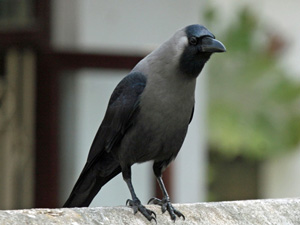
Have you seen this animal? Report it now!
Photos and accurate descriptions of where and when the animal(s) was sighted are critical when making a report. Detailed information allows the Victorian government to make a timely and positive identification. All reports are responded to as a priority and may result in trapping, surveillance and the removal of confirmed house crow.
It is important to report house crow sightings
The house crow is not native to Australia and if given the opportunity could establish and breed in Victoria. If they become established in Victoria they may be a threat to primary production industries, causing severe damage to agricultural and horticultural crops. They also create a nuisance for people through:
- scattering rubbish
- noise
- damaging urban and electrical infrastructure.
House crows are classified as a prohibited pest animal under the Victorian Catchment and Land Protection Act 1994. The importation, keeping, breeding and trading of this species, without appropriate permits, is illegal and penalties apply.
The house crow is not known to occur in the wild in Australia. There have been several reports in Western Australia of their presence, most likely arriving as stowaways on international cargo ships. Given the impact of the species early detection, particularly in the vicinity of Victoria's international shipping ports, is critical to preventing their establishment in the wild.
How to identify a house crow

- black bill, upper beak strongly curved
- glossy plumage with a metallic greenish blue-purple sheen on the forehead, crown, throat, back, wings and tail
- black eyes
- pale grey non glossy tones on nape, neck and lower breast.
Size
Adult house crows are typically 42 to 44 cm in length. They are smaller and more slender than other similar Australian native birds.
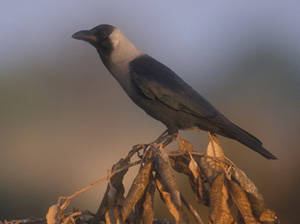
Colour
Their plumage is a glossy black with a metallic greenish blue-purple sheen on the wings, forehead, crown, throat, back, and tail. Their neck, nape and lower breast are a paler grey tone and non-glossy.
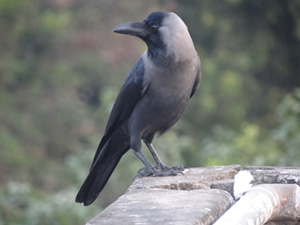
Distinctive features
They have sloped foreheads, dark brown to black eyes and black legs and feet.
Habitat
They nest in an untidy platform of twigs with a cup-like depression, lined with fibres. Some nests are almost entirely composed of stiff wire. The nest can be placed in tree forks, buildings, street-lamps and pylons. They do not use tree hollows.
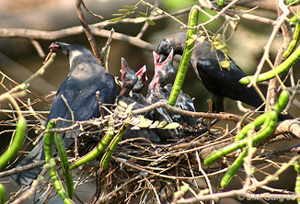
Behaviour
They are gregarious, sedentary birds that are known for their intelligence and boldness. Overseas, thousands of birds have been recorded at communal roosts. Other places they congregate include around food sources such as rubbish tips, abattoirs and markets.
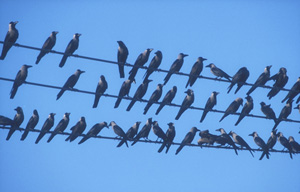
Call
Their voice call is a short repeated 'caw-caw-caw'.
Similar-looking native birds
The house crow is similar in appearance to four native birds found in Victoria.
These are:
- Australian raven (Corvus coronoides)
- little raven (Corvus mellori)
- forest raven (Corvus tasmanicus)
- little crow (Corvus bennetti).
Collectively these are called corvids.
Australian corvids are very similar in appearance to the house crow but can be distinguished by their black plumage, white eyes and are typically larger than the house crow. It is also worth noting that juvenile native corvids can have lighter colour plumage and their eyes are brown colour.
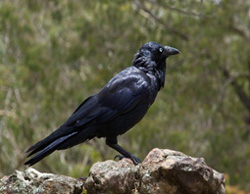
The Australian corvids also have very distinct voice calls:
- Australian raven – drawn-out ‘aah aah aaah aaaaahhh’, with the last note longer
- little raven – hard, harsh, short, deep ‘car car car’
- little crow – ranges from a harsh ‘hark-hark-hark-hark’ to a more raven-like ‘ah-ah-aaaah’
- forest raven – deep ‘korr korr korr’
More detailed information on Australian corvids including a comparison table and downloads of their calls is available on the Bird Life Australia website.
If you still are in doubt as to whether the bird you have seen is a house crow, email photographs to highrisk.invasiveanimals@agriculture.vic.gov.au or use our online reporting form.
Impact on native species
Overseas, the house crow is considered a major pest of the environment, preying on the chicks and eggs of native birds and destroying their nests.
Australian species that could be most affected by house crow include:
- native corvids
- native finch species
- possibly honeyeater species
- small mammals.
Given their scavenging nature, they could also be expected to become a general nuisance.
Acknowledgements
(i) Dick Daniels (http://carolinabirds.org/) (own work) [CC BY-SA 3.0 or GFDL, via Wikimedia Commons.
(ii) Shanthanu Bhardwaj (house crow) [CC BY-SA 2.0, via Wikimedia Commons.
(iii) SupernovaExplosion (Own work) [CC BY-SA 2.0, via Wikimedia Commons.
(iv) JM Garg (own work) [GFDL or CC BY-SA 3.0, via Wikimedia Commons.